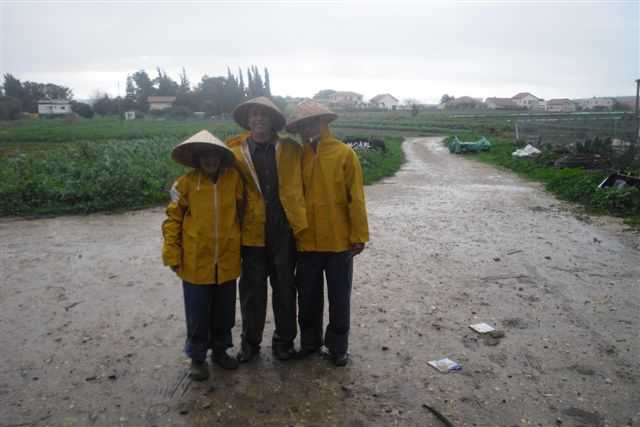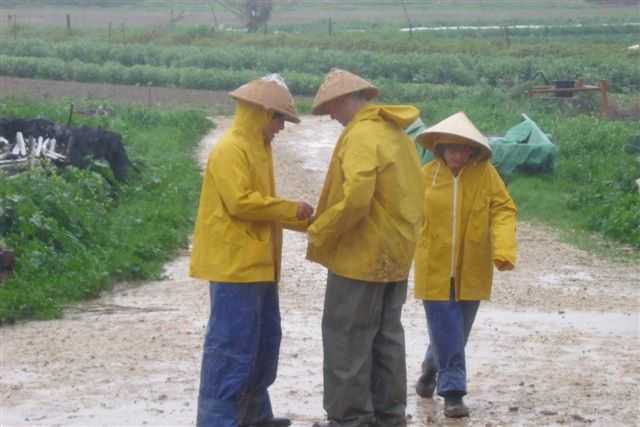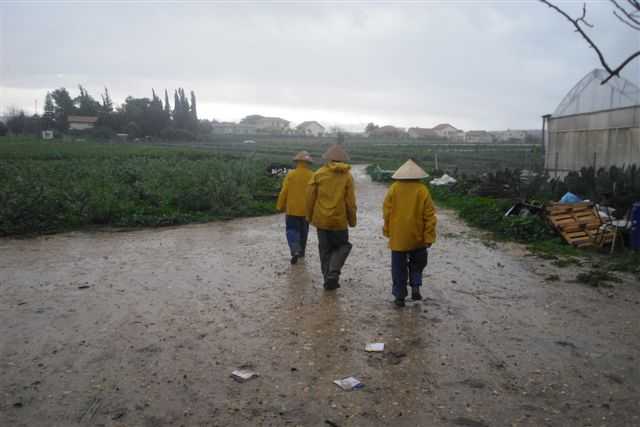Two words from the Chubeza technological division:
– This week we begin upgrading our Internet site. If you suddenly start receiving old newsletters sent to your mailbox, please look upon this as a temporary glitch on the way to better technology for Chubeza. (Our apologies in advance.)
– As a further step in upgrading, we’re now able to publish the English newsletter on the website, and you’ll be able to automatically get the updates every Wednesday. Over the next week, we’ll sign you up to receive the newsletter through this system. You should receive an e-mail from feedburner asking you to confirm the sign-up by clicking on a link – click and you’re in!
_______________________________
Rain, rain, don’t go away!
The past two weeks have been rainy– although the weekend was dry and dusty– and now the forecast is for more rain towards the end of this week. I wanted to share some of the experiences of a wet winter at Chubeza (what joy!).
Today, we were visited by some very smart, sensitive children, who saw the rain gauge and decided it was an emotion gauge. And basically, they’re right as rain, so to speak. The rain gauge accurately gauges the happiness of the Chubeza team when the rain comes down in buckets and waters the fields. Last winter was gloomy, dry, cold, frozen and almost rainless from December to February. So far this winter, we have been blessed with nice showers, along with good dry interludes to allow our field to quench its thirst. Not that life is so easy in the rain and mud. We try to schedule our picking according to the rain forecast, and many times we pick most of the vegetables a day before the predicted rain. Still, there’s usually no recourse from picking in the rain. We try to dress accordingly: boots, rainproof pants, storm jackets and umbrella hats. Last Monday, under the pouring rain, we trotted out to pick the last of the greens. Lobsang, Alon and Rachel modeled their storm wardrobe for us:

A few final zip-ups:
And… out they charge:
Working in the rain, or a day or two after rain, means rolling in the mud–and when I say rolling, picture boots loaded halfway with sticky, brown, wonderful, heavy mud. And when I say heavy, picture us walking only by contorting every muscle from hip to toe to be able to lift each foot to take baby steps towards the next garden-bed. On the way back to the packing house, we try to shed as much mud as possible by jumping around, dancing (tap-like), rubbing against flora on the road, and trying to leave as much of the brownness around us. Removing the boot at the end of such a workday is like growing wings. You lose your sense of gravity and are ready to fly…
Our packing house fills with mud, and sometimes we need to use the shovel to clear the path to the door so that it can open and close. You’ve been receiving a lot of mud and rain in your boxes, in the bags and on the vegetables. Some of you may not enthusiastically greet the muddy box appearing at your door. Yet while there is no getting out of thoroughly washing the vegetables, there is an added bonus. Chana, who volunteered here last year, taught me that mud is a great grease remover. Just like sand is used for cleansing, the muddy globs can rub off stubborn stains, especially from metal utensils. So if you have a pot with black, hard-to-remove stains inside, try this: place the muddy vegetables you receive in your box (carrot, beets, kohlrabi, radishes, celeriac, parsley root, etc.) in the stained pot and cover with water. Now prepare yourself a cup of tea and relax—let the water do its work, softening the mud and separating it from the vegetables. After some time (a couple of hours or so), go back to your muddy vegetables, remove from pot, and wash under running water. Allow vegetables to dry thoroughly on a towel, then place in air-tight containers and refrigerate. Meanwhile, back to the stained pot: Carefully pour out the water, but don’t spill out the mud remaining on the bottom. Use it to rub the sooty parts of the pot and then rinse out. The result will be a surprisingly brilliant one.
The most recent rains made us change our plans: in the beginning of the winter, we designated two one-sixth plots of our new field to spring planting, which is presently commencing. Initially, we planned on first cultivating the upper plot, and two weeks ago Gaby took the tractor to open up the garden beds, cultivate the weeds and prepare the earth. Post-factum, we learned that this may have caused more rain to be absorbed and permeate to the ground level. When Gaby arrived this Sunday to work the soil in preparation for Tuesday’s planting, we discovered that the upper plot is very wet and saturated, and of course, cannot be cultivated. An attempt to work the lower plot proved slightly more successful, allowing us to make a quick diversion in plans and designate the lower for first planting.
On Tuesday we hope to begin spring planting. Many new plants await their acquaintance with our earth, accompanied by potato seeds and other vegetables that enjoy coming up over the second half of winter. Some of them will be protected by Agril or plastic row-covers; others are strong enough to withstand this cold season unprotected. Tuesday will be a very busy day, a real race against time before Wednesday’s rains catch up with us. Wish us luck!
Wishing you all a great wintry week, awaiting the blessed rain and small wintry steps towards spring’s awakening,
Alon, Bat Ami and the Chubeza team
_______________________________________
This week’s basket includes:
Monday: We weren’t able to find cucumbers, so we sent you potatoes instead.
Lettuce, carrots, parsley, tomatoes, broccoli, celery, green cabbage, kohlrabi, potatoes, fava beans – small boxes only.
In the large box, in addition: cauliflower, beets, leek, and fennel.
Wednesday: cauliflower or broccoli or kohlrabi, green cabbage, tomatoes, parsley, celeriac, tatsoi or mustard greens, fennel, carrots, lettuce, cucumbers, cilantro or dill.
In the large box, in addition: radish or daikon, green onions, Swiss chard or kale.
___________________________
Over the past few weeks you’ve been receiving fava beans (ful) in your boxes. We don’t have great quantities just yet, so we alternate: some for Mondays, some for Wednesdays, some for the big boxes, some for the small. I’ve received inquiries regarding these beans, so for those who are curious, a few words about favas (or “broad beans”):
Full belly
In the fava bean season, it is hard to work in the field without noshing. The green, juicy snacks wink at us and beckon from the bushes, begging to be sampled. Even when I take them home, fully intending to cook them this time, I find myself gobbling at least half before the stove burners are set alight. The green favas are one of the few vegetables that are still present only in their season, usually the beginning of spring. In our first year, there was something frustrating about that: on our first Open Farm Day which took place over Chol Hamoed Pesach, our garden beds were bursting with fresh favas and fresh peas, to the chagrin of many of our Ashkenazi Jewish clients who were forbidden to eat kitniyot during Pesach. This year we sowed the fava beans early so you can enjoy them as a pre-Pesach treat.
But the story of the favas begins last fall. There is something beautiful about it, something that brings us back to our world of endless possibilities, the restraints of time and seasons, and slower, more silent rhythms of life. This year we sowed the fava in the middle of autumn and then again at the end of the season, attempting to hide it deep in the earth before the first showers hit. The rain covers them with earth, greeting with fanfare the big, familiar seeds, its friends from last year. This encounter results in quick germination of the favas, which courageously burst forth and continue growing even as the winter grows colder and rainier. The growth is slow and calculated. It takes its time, growing over an entire winter, patiently and steadily, elevating itself only ever-so-slightly every week. It covers the earth and protects the soil from erosion and rain damage. It crowds densely, preventing weed growth. Favas do not require fertilization, for like their siblings from the legume family, fava beans can fix nitrogen to fertilize themselves and enrich the soil within which they grow.
After months of rain, wind and cold, the fava feels something moving inside. With its special plant sense, it feels the changing seasons, the days growing longer, the different light, and the sun’s locale—and then it knows that it’s time to smile. The fava smiles with fabacaea butterfly-like flowers that are both strong and gentle, so appropriate for this vegetable. In confident pastel festivity, they overtake the garden beds as if to say, we’re all clean and dressed up, and something wonderful is about to happen. Even during blooming, the fava takes its time- what’s the rush when it can look around and take time to smell the flowers. The garden bed appears as if it stopped at the flowering stage, while nothing else has changed. But slowly, almost imperceptibly, a small green boat appears in the flower. This boat will thicken and put on weight until it turns into a pod with seeds. We pick them before they fully ripen and dry, while they’re still green, fresh, sweet and juicy. And by then we know that spring is almost here.
Although the green fava characterizes the season of renewal, courtship and vitality, over its long history it was affiliated ith death– perhaps because in farming and in general, life and death are bound together in a close, fateful dance. The dry and green fava beans have been consumed in the Middle East, and in north and South Africa for thousands of years. Fava remnants have been found in archeological sites in the Middle East from as early as 6500 BC! It served as an important, key food for all classes. Fava is rich in protein, complex carbohydrates, and dietary fibers. It contains a good amount of iron, folic acid, potassium, magnesium and zinc. In ancient times, the Greeks, Romans and Egyptians believed that the spirits of the dead wander into the fava’s buds, making it a popular food at funeral meals. Possibly the connection between the fava and the afterworld has to do with the fava allergy, also known as Favism (from the Latin Vicia faba). This allergy is very serious, deriving from a genetic deficiency in the G6PD enzyme. Fava consumption among some 20% of humans lacking this enzyme can result in acute anemia and even death. This phenomenon is three times more prevalent among men. The allergy is common among populations from three areas: Greece, southern Italy and the Aegean Sea; the Mediterranean shore of Africa, specifically Morocco and Egypt (in Israel it is mostly common among Iraqi Jews); and central Asia and China. The discovery of this allergy raised the surprising question: why did people continue eating fava in those areas, despite the clear risk to such a high percentage? The answer is fascinating: apparently the fava has chemical components similar to those in quinine medicines used to treat malaria, a once-common disease in Greece and southern Italy. It seems the fava fights malaria in a similar way to the anemia resulting from the G6PD deficiency, i.e., by reducing the amount of oxygen within red blood cells. The season of picking fresh fava, springtime, is also the breeding season of the malaria-transmitting Anopheles mosquito. So although fava is dangerous to part of society, its benefit to society as a whole outweighs its drawbacks.
Another reason why fava should be part of our natural medicine chest is for the treatment of Parkinson’s Disease. Fava naturally contains the L-Dopa amino acid, which becomes the Dopamine neurotransmitter upon reaching the brain and improves the condition of Parkinson’s sufferers, as the disease results from Dopamine deficiency. Even 250 grams of cooked fava has proven to significantly boost the level of Dopamine in the blood, improving the patient’s condition. The largest concentration of L-Dopa is in the green fava and its pods–dry fava contains much less. Research is still in the early stages, and those considering fava for the treatment of Parkinson’s should consult with their doctor.
In Israel, there are two varieties of fava, the larger Cypriot or Italian fava (which we grow in Chubeza), and the Egyptian fava, which is smaller, almost the size of a pea pod. In Egypt, fava is called “Ful Hamam” for a fascinating reason: in Medieval times, preparation of the fava was exclusively carried out by those who lived in the area surrounding “the princess baths”- the public baths at the site of the Fountain of Mohammed Ali Pasha in Cairo. During the day, the water in the great basins was heated for bathing. By night, when the burning coals were still ablaze, the great basins were filled with dry fava beans which cooked on the coals overnight to provide breakfast for the residents of Cairo.
There are many ways to prepare green favas. Some of the simplest are:
Cook in unsalted water (similar to blanching peas–the salt hardens the skin).
Sauté onion and garlic, then add fava, boiling water and lemon juice, and cook for 15 minutes till liquid is absorbed.
Turn oven to low heat, and place garlic and such fresh herbs as rosemary, thyme or za’atar on a lightly olive-oiled baking sheet. Add the fava and bake slowly. When the fava is very soft, crush together with the garlic and herbs and spread on bread.
The fava bean does not have to be peeled! The skin can definitely be cooked and eaten.
This week I’m including a host of recipes, but I must admit that although they sound delicious, I never get around to actually preparing the recipes, for– as previously mentioned– in our home the fava is eaten fresh the minute it pops out of the pod.
_________________________________
Recipes for Fresh Fava Beans – some for beans in the pod:
Fresh Fava Beans, Indian-Style – Noam Lipshitz, from www.ynet.co.il
Ingredients: (Serves 6) 1 kilogram fresh fava beans in pods 2 tomatoes, crushed 200 grams tomato sauce 2 c. water 3 T. Indian curry powder 1 T. cumin 2 T. sweet paprika 4 dried chili peppers 2 onions, finely chopped in food processor 4-5 T. oil Salt 1 T. sugar
Preparation: Remove fava beans from pod. Heat oil in saucepan and add curry powder, cumin and paprika. Sauté for around 3 minutes. Add the fava beans and sauté with the spices for around 2 minutes. Add chopped onion and sauté for an additional 2 minutes. Add crushed tomato and stir well. Bring to a boil. Add tomato sauce, 2 cups boiling water, sugar and salt. Adjust seasoning to taste. Add chili peppers and bring to a boil; lower flame and cook for 1½ hours. The chili peppers add a special spicy flavor, but they can be omitted if desired.
Fresh Fava, Syrian-Style
Ingredients: 500 grams beef 1 kilogram small fresh fava, unpeeled, sliced 1 bunch fresh coriander 10 cloves garlic Salt, black pepper, allspice to taste 4 T. canola oil
Preparation: Place meat in pot; add water to cover and cook till soft. Rinse fava beans several times in cold water, drain and trim edges. Cut into 3 cm. pieces with peeling. Add canola oil, crushed garlic, fresh fava beans, and coriander. Steam mixture for several minutes. Add cooked meat and its cooking liquid, spices and salt. Note: It’s also possible to gradually add the cooking liquid to make gravy. Best served with rice.
Fresh Fava Beans in Pods with Tomato Sauce
Ingredients: 750 gm. fresh fava beans, in pods 1 large onion 1 large tomato 1 T. tomato sauce 3-4 garlic cloves 4 T. olive oil Salt to taste Black pepper to taste 1 T. cumin 1 T. sumac Lemon salt (citric acid) or lemon juice to taste Water, as needed
Preparation: Cut onion into small cubes and sauté in olive oil. Chop garlic and add; add all spices. Peel tomato and cut into cubes, add to chopped onion. Add tomato sauce and half cup water, cover and cook over low flame. Rinse fava beans well, cut into 2-centimeter slices, and add to mixture. If needed, add a small amount of water and continue to steam in covered pot till soft.
Moroccan Tagine of Fava Beans and Artichokes
Moroccan Fava Beans in Tomato Sauce
Fresh Ricotta and Fava Bean Bruschetta
Two Fava Bean Favorites: Bissara (Fresh Fava Bean Dip) and Fava Bean Relish


